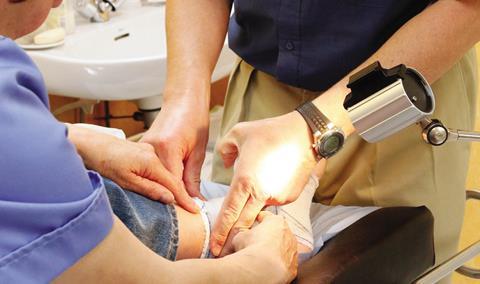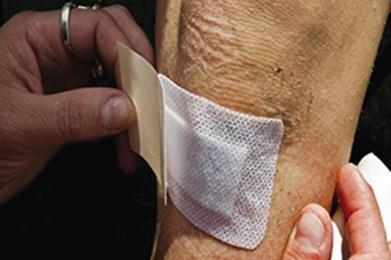Older people’s wounds heal more slowly. With an ageing population, this means the NHS must rethink wound management. By Claire Read

Wound management needs to be efficient
When Mark Collier joined United Lincolnshire Hospitals Trust, he was the organisation’s first tissue viability nurse. Almost a decade later, he leads a team of seven, all of whom focus solely on the management and treatment of wounds.
More from this supplement
Growing numbers
The expansion of the team shows the growth and increasing importance of this speciality. It is estimated that 200,000 people in the UK have a chronic wound – generally defined as one which does not heal within three months – and a 2008 study put the cost of care for these individuals at £2.3bn-£3.1bn a year. That means three per cent of the NHS budget is now spent on chronic wound care.
The numbers are already significant but incidence and costs are only set to grow, warns Mr Collier: “The reality is it’s going to get worse, it’s not going to get better.”
Estimates suggest that the number of wounds will rise by 10 per cent in the next five years alone. The main reason is the ageing population.
‘It’s going to get worse, it’s not going to get better’
“Surgeons are doing surgery on older patients that they wouldn’t have entertained even 10 years ago,” explains Mr Collier, who in addition to his role at United Lincolnshire is a council member of the European Wound Management Association. “And obviously you’ve got advances in medicine and surgical techniques and equipment, so consequently you’ve got older people who are having more complex surgery.
“With the ageing process, the reality is that even if a 96-year-old were fully fit, went to the gym every day, never smoked, never drank, had a well balanced diet, the healing process would be slower than it is if you’re 46. And if the wound isn’t healing as quickly, it’s more prone to potential complications.
“The incidence of chronic wounds is rapidly going up, because a percentage of the acute wounds [are] becoming chronic, but also because of things like leg ulcers which are associated with diminished circulation and so tend to happen later in life.”
Efficient management
The scale of the issue is such that staff at many organisations are considering ways to make wound management processes more efficient. And that is not just the case in hospitals. The reality is that the focus on care closer to home and the long term nature of chronic wounds means much of the burden will fall in the
community setting.
Until recently Heather Joy was senior operations manager for adult nursing and modernisation at Hull’s City Health Care Partnership Community Interest Company. She reports that wound care has been a particular area of organisational focus for around five years.
‘We were continuously looking at ways of improving and making efficiencies’
“We had taken over the budget for the consumables that were needed for wound management,” she explains. “So whereas traditionally in many areas nurses would ask GPs to write prescriptions, we’d worked very closely with the CCG and top-sliced that prescribing budget so we had ownership of it. The nurse would say, ‘This is the dressing you need,’ the dressings would be taken in, and the patient didn’t have to rely on a prescription going to the GP.
“In doing that, we had seen some significant savings and reduction in waste. We were continuously looking at ways of improving and making efficiencies.”
Newer methods

That exploration centred on two issues: first, the number of dressings used and, second, the number of visits community nurses were making to wound care patients. However, one specific change made it possible to address both issues at once. The organisation started to use a new dressing, which needs replacing less frequently. It also has a surface which changes appearance when a new dressing is needed – helping patients to better understand their condition.
“The dressing was slightly more expensive compared to some of the others, but the value was in reducing the amount of visits,” explains Ms Joy. “We were increasing the amount of time that nurses have to be with patients by them not undertaking unnecessary visits.
“We also got the patients and the carers involved by saying, ‘Our plan is to see you in a week’s time. Here is a guide – if the dressing looks like this contact us and we will come out to you.’”
‘It’s taking a long term view and investing to save’
An evaluation of the change – conducted with the dressing supplier – showed near universal reductions in visit frequency for dressing change in patients using the new product. Ms Joy admits that not all people were suitable for the change: long term patients who had become used to regular visits were resistant, particularly if they were socially isolated.
“But it gave us time to look at making every contact count,” she says. “What else have we got around us, and what voluntary organisations could help with social isolation if we’re not visiting you as often?”
Following the evaluation, the dressing is now on the local formulary “with strict guidelines as to who it’s used for”, says Ms Joy. The value of having a clear and considered formulary, with advice on which dressings to use for which patients, is also emphasised by Mr Collier.
“I think it’s about taking the long term view rather than going for quick wins,” he suggests. “If you only go from cost, what we’ve found is that you actually use more of that dressing: in principle it might be a similar product but it’ll be less absorbent. I would never say expensive is best, and I would never say discount a product because it’s cheap. But it’s making sure you’re aware of the whole picture.
“Obviously it’s very easy to save money by simply changing the dressing to a cheaper one, but actually the outcome could then become that it takes longer for the patient to heal. It’s taking a long term view and investing to save.”
What is undeniable, he argues, is the scale of the need – and that it is increasing. “With the ageing population, I can put my hand on my heart and say there is not one patient in the country who will go into any healthcare setting who doesn’t have a tissue viability need.
“It will be preventative – for example, preventing pressure ulcers – or it will be management, because they will have an existing wound or skin condition that needs to be managed.”
Paul Trueman on the better use of nurse time
For over a decade, health policies have promoted shifting patients from acute care settings to community and home on the basis this can improve access to care, make care more patient centred, and reduce the use of high cost acute care facilities. All fine principles in theory but in practice this is a more challenging proposition.
With no significant investment in extra capacity in community nursing, these changes create additional demands on an already overstretched resource.
Community nurses often highlight the management of patients with a chronic wound as consuming significant amounts of their time.
While chronic wounds are rarely life threatening, they can consume a disproportionate amount of nurse time compared to other chronic conditions. Just consider how often a patient with adequate control of their diabetes is seen by a GP or community healthcare provider – perhaps once a month, maybe once a quarter?
In contrast, a patient with a chronic wound will typically require 3-4 nurse visits per week, simply to change their dressings and monitor the progress of their wound. Furthermore, many patients require ongoing care over months and often years.
Despite this, chronic wounds rarely figure on a list of priorities for commissioners, which tend to be dominated by conditions like diabetes, respiratory illness and cardiovascular disease.
Yet simple actions can be put in place to make better use of nurse time: reducing the number of nurse visits required for dressing changes; educating patients to play a greater role in self-care; simplifying dressing formularies to make product selection easier for nurses; and intervening actively and early to avoid wounds reaching a chronic stage, resulting in the need for time consuming ongoing care. The best practice guidelines and wound care technologies required to achieve improved efficiency are readily available.
At Smith & Nephew, we recognise that delivering high quality wound care is no longer just about providing dressings and innovative technologies.
We also have a role to play in partnering with healthcare providers, helping to think about how our products might support changes in service delivery and reduce the burden of wound management.
We believe that embracing innovative wound solutions can help to release nurse time to care and ultimately deliver improved patient outcomes.
Paul Trueman is vice president of market access for Smith & Nephew
Excellent care supplement: Taking NHS standards to the next level
- 1
- 2
- 3
- 4
 Currently reading
Currently readingSupplement: It's time to heal wound management






























No comments yet